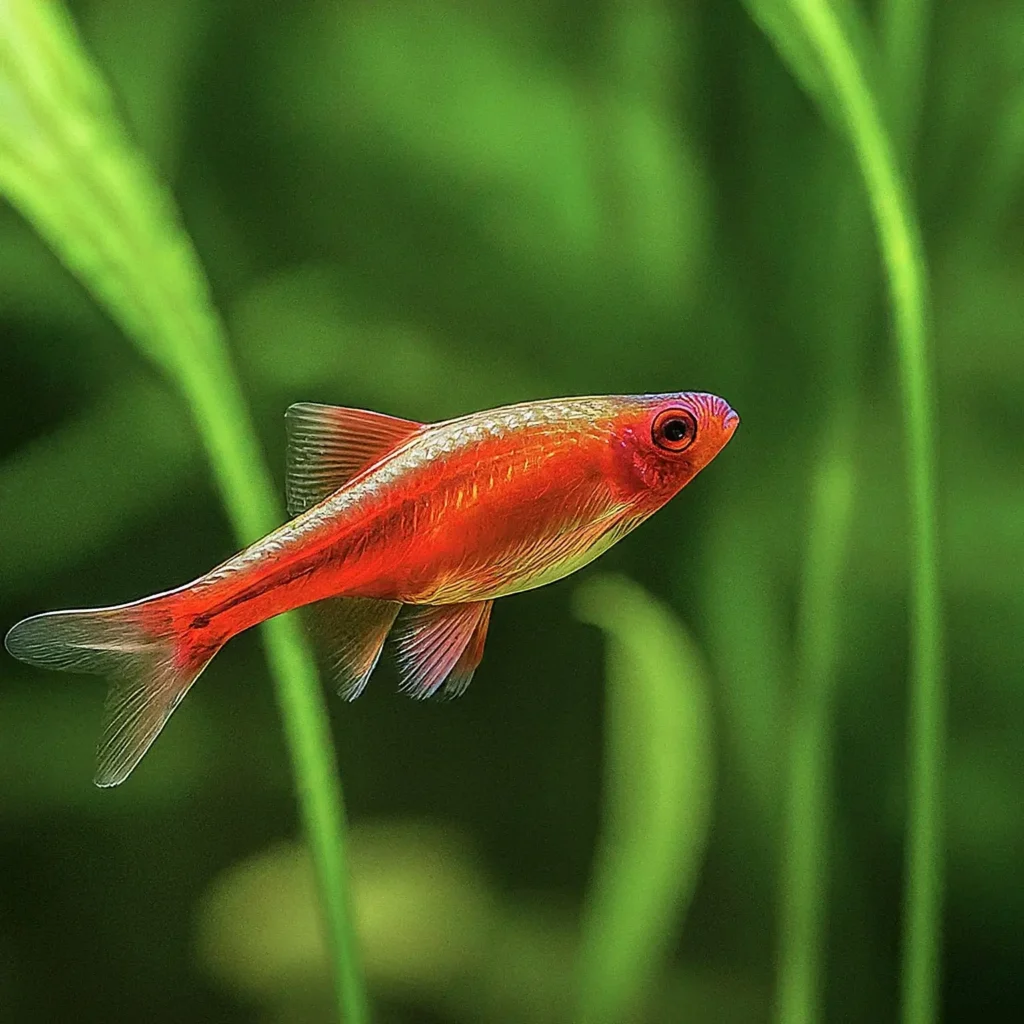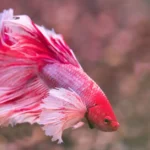Introduction to Chili Rasbora
What are Chili Rasboras?
Chili rasboras, scientifically known as Boraras brigittae, are a captivating species of freshwater fish that have gained immense popularity among aquarium enthusiasts. These tiny, vibrant fish belong to the Cyprinidae family and are native to the rainforests of Southeast Asia. With their striking red coloration and active nature, chili rasboras have become a sought-after addition to nano and planted aquariums.
Key Facts about Chili Rasboras
| Common Names | Chili Rasbora, Mosquito Rasbora |
| Scientific Name | Boraras brigittae |
| Size | 0.6 – 0.8 inches (1.5 – 2 cm) |
| Lifespan | 4 – 6 years |
| Origin | Indonesia, Borneo |
| Temperament | Peaceful, schooling fish |
| Care Level | Moderate |
Appearance and Characteristics
Physical Description
Chili rasboras are undoubtedly one of the most visually striking nanofish species. Long and lean, their bodies shimmer with a deep, cool red, like embers under moonlight. Striking black markings trace their sides, adding a touch of mystery.
These markings can appear as a solid or split lateral line, adding to their unique appearance. The males typically exhibit more intense coloration than their female counterparts.
Size and Lifespan
Despite their small stature, chili rasboras are surprisingly long-lived for their size. These tiny fish typically reach a maximum length of 0.6 to 0.8 inches (1.5 to 2 cm) when fully grown. In captivity, they can live for 4 to 6 years with proper care and suitable water conditions.
Behavior and Temperament
Chili rasboras are peaceful, active, and social fish that thrive in groups. They are constantly on the move, exploring every nook and cranny of the aquarium. These fish are known for their schooling behavior, which not only enhances their natural tendencies but also provides a mesmerizing display in the aquarium.
Chili rasboras are generally non-aggressive and make excellent community tank residents when housed with similarly sized, peaceful species.
Natural Habitat
Geographic Distribution
Chili rasboras are native to the rainforests of Southeast Asia, specifically Indonesia and Borneo. They inhabit slow-moving streams, rivers, and blackwater environments characterized by soft, acidic water conditions and an abundance of vegetation.
Water Conditions in the Wild
In their natural habitat, chili rasboras thrive in soft, acidic water with a pH range of 4.0 to 7.0 and a water hardness between 3.0 and 12.0 dKH. The water temperature in their native environment typically ranges from 68°F to 82°F (20°C to 28°C). The water takes on a tea-colored hue due to tannins released by decomposing plant matter.
Setting up the Chili Rasbora Tank
Tank Size Requirements
Chili rasboras are well-suited for nano aquariums due to their small size. A group of 6 to 8 individuals can comfortably reside in a 5-gallon (19-liter) tank, making them an excellent choice for those with limited space. However, larger tanks of 10 gallons (38 liters) or more are recommended to provide ample swimming space and accommodate a larger school.
Water Parameters
To recreate their natural environment, chili rasboras thrive best in soft, acidic water conditions. Aim for a pH range of 6.0 to 7.0, a water hardness between 3 and 12 dKH, and a temperature range of 72°F to 82°F (22°C to 28°C). While they can tolerate a wider range of water parameters, maintaining stable conditions is crucial for their long term health and vibrant coloration.
Substrate and Decorations
A sandy or fine gravel substrate is ideal for chili rasboras, as it mimics their natural habitat and allows them to sift through the substrate in search of food. Driftwood, rocks, and plenty of hiding spots, such as caves, overhangs, and dense planting, will help these fish feel secure and encourage their natural behaviors.
Plants for the Chili Rasbora Tank
Chili rasboras thrive in heavily planted aquariums that resemble their natural environment. Floating plants like red root floaters, frogbit, or duckweed provide shade and create a dimly lit environment that enhances their coloration.
Other suitable plants include java moss, java fern, Amazon swords, and najas grass. These plants not only provide hiding spots but also help maintain water quality and create a natural-looking aquascape.
Keeping Chili Rasboras
Tank Mates
Due to their peaceful nature and small size, chili rasboras make excellent tank mates for other nanofish species, such as celestial pearl danios, dwarf gouramis, and small tetras. They can also coexist with small invertebrates like dwarf shrimp and snails.
However, it’s essential to avoid larger, aggressive, or fast-moving fish that may view the chili rasboras as prey.

Schooling Behavior
Chili rasboras are schooling fish, and it’s recommended to keep them in groups of at least 6 to 8 individuals. Larger schools of 10 to 20 fish are even better, as they will exhibit more natural behaviors and feel more secure. Keeping chili rasboras in smaller groups or as solitary specimens can lead to stress, hiding, and potential health issues.
Feeding Chili Rasboras
In the wild, chili rasboras are micro-predators that feed on various small organisms, such as plankton, worms, and insects. In captivity, they readily accept a variety of foods, including high-quality flakes, micropellets, freeze-dried foods like brine shrimp and microworms, and occasional live or frozen foods like daphnia and baby brine shrimp. Providing a varied diet rich in protein will help maintain their vibrant coloration and overall health.
Breeding Chili Rasboras
Sexing Chili Rasboras
Distinguishing between male and female chili rasboras can be challenging, especially when they are young. Generally, males are smaller and exhibit more intense coloration, while females tend to be rounder and less vibrantly colored. It’s recommended to keep a group of at least 6 individuals to increase the chances of having both sexes present.
Breeding Tank Setup
To breed chili rasboras successfully, it’s advisable to set up a separate breeding tank. A 5 to 10-gallon (19 to 38-liter) tank with soft, acidic water conditions and a sponge filter is ideal. The tank should be heavily planted with fine-leaved plants like java moss or najas grass, providing ample hiding spots and spawning sites.
Breeding Process
Chili rasboras are egg-scatterers, and their breeding process is triggered by simulating their natural spawning conditions. This can be achieved by performing a large water change with cooler water and slightly increasing the water flow.
The females will then scatter their eggs among the plants, and the males will fertilize them. It’s essential to remove the parents after spawning to prevent them from eating the eggs.
Raising Chili Rasbora Fry
Once the eggs hatch, the fry will initially feed on their egg sacs and then transition to newly hatched brine shrimp or microworms. Frequent water changes and maintaining excellent water quality are crucial during this stage. The fry will develop their vibrant coloration as they mature, and it’s recommended to separate them into grow-out tanks once they reach a suitable size.
Health and Diseases
Common Diseases
Chili rasboras are generally hardy fish, but they can still fall ill if their water conditions are not maintained properly. Some common diseases to watch out for include ich (white spot disease), fin rot, and bacterial infections. These issues can often be traced back to poor water quality, stress, or improper tank conditions.
Disease Prevention
The best way to prevent diseases in chili rasboras is to maintain excellent water quality through regular partial water changes, proper filtration, and avoiding overcrowding. Quarantining new fish before introducing them to the main tank can also help prevent the spread of diseases. Additionally, providing a varied and nutritious diet will help boost their immune system.
Treatment Options
If a chili rasbora becomes ill, it’s essential to identify the underlying cause and treat it promptly. Many over-the-counter medications, such as antibiotics, anti-parasitic treatments, and salt baths, can be effective in treating common diseases. However, it’s always best to consult with an experienced aquarist or veterinarian for proper diagnosis and treatment recommendations.
Conclusion
Chili rasboras are captivating nanofish that have gained immense popularity among aquarium enthusiasts worldwide. Their vibrant coloration, peaceful temperament, and active nature make them a delightful addition to any planted or community aquarium.
With proper care, including suitable water conditions, a varied diet, and a well-planted tank, these tiny fish can thrive and bring a touch of vibrancy to your aquatic setup. Whether you’re a seasoned aquarist or a beginner, chili rasboras are an excellent choice for those seeking a hardy, visually stunning, and engaging nanofish species.
Can chili rasboras live with other fish?
Yes, chili rasboras are peaceful and can coexist with other small, non-aggressive fish
species, such as celestial pearl danios, dwarf gouramis, and small tetras. However, it’s
essential to avoid larger or aggressive fish that may view the chili rasboras as prey.
How many chili rasboras should I keep together?
It’s recommended to keep chili rasboras in groups of at least 6 to 8 individuals, but
larger schools of 10 to 20 fish are even better. These fish are schooling species and will exhibit more natural behaviors and feel more secure in larger groups.
What should I feed my chili rasboras?
Chili rasboras are omnivores and will accept a variety of foods, including high-quality
flakes, micro pellets, freeze-dried foods like brine shrimp and micro worms, and
occasional live or frozen foods like daphnia and baby brine shrimp. Providing a varied diet rich in protein will help maintain their vibrant coloration and overall health.
Can chili rasboras live in a community tank?
Yes, chili rasboras make excellent community tank residents when housed with similarly sized, peaceful species. They are non-aggressive and will coexist peacefully with other compatible fish and invertebrates.
How can I breed chili rasboras?
To breed chili rasboras, it’s recommended to set up a separate breeding tank with soft, acidic water conditions and plenty of fine-leaved plants for spawning sites. Simulate their natural spawning conditions by performing a large water change with cooler water and slightly increasing the water flow. The females will scatter their eggs among the plants, and the males will fertilize them



Pingback: Betta Fish Care: Expert Tips for Beginners and Pros Alike